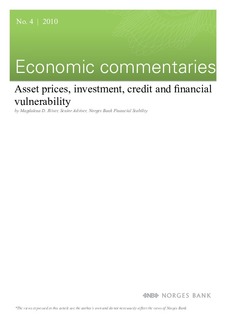| dc.contributor.author | Riiser, Magdalena D. | |
| dc.date.accessioned | 2018-08-23T07:51:19Z | |
| dc.date.available | 2018-08-23T07:51:19Z | |
| dc.date.issued | 2010 | |
| dc.identifier.uri | http://hdl.handle.net/11250/2558984 | |
| dc.description.abstract | Previous analyses indicate that macroeconomic gap indicators for house prices, equity prices, investment and credit are useful in predicting periods of financial instability in Norway. The indicators show, with few exceptions, a common pattern with widening gaps from one to six years ahead of the periods and a subsequent decline. Owing to statistical revisions, the investment gap and the credit gap have been changed somewhat back to the 1940s, but the conclusions remain unchanged. The critical value of the credit gap has been reduced, however. The house price gap, investment gap and credit gap were higher than their critical values in 2007 and are now falling even though the credit gap was higher than its critical value again in 2009. A fall in the indicators shows, in isolation, that financial imbalances are diminishing. At the same time, historical experiences show that the financial system is particularly vulnerable during periods of adjustment. | nb_NO |
| dc.language.iso | eng | nb_NO |
| dc.publisher | Norges Bank | nb_NO |
| dc.relation.ispartofseries | Economic Commentaries;4/2010 | |
| dc.rights | Attribution-NonCommercial-NoDerivatives 4.0 Internasjonal | * |
| dc.rights.uri | http://creativecommons.org/licenses/by-nc-nd/4.0/deed.no | * |
| dc.title | Asset Prices, Investment, Credit and Financial Vulnerability | nb_NO |
| dc.type | Others | nb_NO |
| dc.description.version | publishedVersion | nb_NO |
| dc.subject.nsi | VDP::Samfunnsvitenskap: 200::Økonomi: 210::Samfunnsøkonomi: 212 | nb_NO |
| dc.source.pagenumber | 5 | nb_NO |

